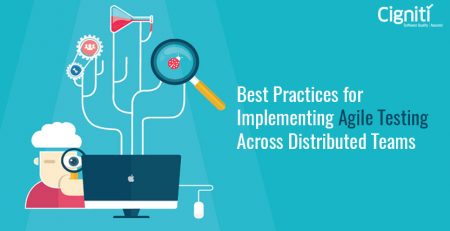Putting Quality First Through Continuous Testing
The one thing that can make or break an organization in today’s competitive age is the Quality of the products it creates. To meet, and then beat the severe competition, every organization must be able to showcase excellence in their offerings and deliver quality, robust applications.
Delivering a Quality product implies delivering a product that provides the best performance according to users’ requirements, and is bug-free.
To meet this requirement, every organization is scouting for newer, yet proven ways of working that can help their teams work in a seamless manner to produce the most reliable product. In their search for well-established processes, a lot of companies are making an effort to adopt DevOps as part of their culture.
DevOps creates a culture that helps in achieving the goals of quality and time to market by employing the following means:
- Collaborative Development: Or shift-left to increase the understanding and collaboration between cross-functional teams
- Continuous Integration (CI) & Continuous Testing (CT): While Agile suggests continuous integration and testing, it does not call it a mandatory function. In a DevOps environment, however, both Continuous Integration & Continuous Testing are mandatory to be performed. This has a huge impact on the quality of a product.
- Continuous Release and Deployment: With a shippable product ready after every integration, there is a marked increase in the frequency of product release and deployment
- Continuous Monitoring: Continuously monitoring the performance of a product helps improve the quality multifold.
So once you begin your shift-left journey, and things become more streamlined across functions, CT of your product is what needs to be planned for, and implemented.
CT, per Wiki, is “the process of executing automated tests as part of the software delivery pipeline to obtain immediate feedback on the business risks associated with a software release candidate.”
There should be a mechanism to check for feedback at the end of each phase to check whether the product is all ready for the next phase – or it requires some corrective actions before moving ahead.
CT aims at delivering go-to-market ready, high-quality, robust working code at a frequency and ensures quality at every phase of the app’s development. It comprises Unit tests, API testing, Integration testing, and System testing at each phase of SDLC, thus incorporating consistent quality checks at every step of the SDLC process starting with design, building the app and through all phases of production. An effective testing and quality process enables faster time to market, constant releases and minimizes risks in the post production phase. For instance, in the Automobile segment, Continuous Testing at every phase of the production process is inevitable.
Following is a list of the fundamental objectives of Continuous testing:
- Get a holistic view of the application / product
- Ensure efficacy, quality, and robustness
- Flawless delivery
- Faster time to market
So how exactly does Continuous Testing help promote Quality?
Continuous Testing facilitates and empowers you with an automated, seamless way to obtain prompt feedback on the business risks associated with the application / product. This helps maintain quality, but ensures effective entry in the market place.
Following are a few activities performed as part of the CT process that help create – and promote – Quality of a product:
- Use a Version control system for the automation test scripts: Proper, centralized management of test scripts makes it easier for everyone involved to use the critical asset. This helps provide anytime access to all the latest test scripts that need to be executed. Removal of ambiguity with regards to the latest code builds and accessibility has a direct impact on the speed of test execution and the generation of the quality results as expected.
- Integrate the build deployment tool with an automation suite: Integrating the build deployment tool and the automation suite helps centralize the execution of tests and the reporting of the results. This helps increase the speed of test executions, thus reducing the go-to-market time. Again, centralization of the activities will help testing everything – thus creating a more robust and reliable product.
- A few typical tests run at each checkpoint are the health checks (- if the services are up as required), smoke tests (- if the key features are operating as planned and there are no critical defects), and regression tests (- controls the feedback time by executing automated tests in parallel via multiple threads or machines).
In case of any failure, all deployment must be stopped and the entire DevOps team – developers, testers and operations staff – starts taking the required corrective action. These continuous, frequent feedback loops help create a stable, quality product.
For example, with the consistent innovation and demands in the segment of Mobility services, continuous Quality checks related to performance, usability and security are a must to create high quality mobile apps across various development platforms.
While testing is often ignored when it comes to DevOps – it may actually prove to be a major blow to your dream of achieving true success. Cigniti Technologies helps you realize the gains that DevOps can bring with a proper automated testing framework in place. Integrating automated testing with your DevOps is the best thing to do if you want to save on time and money, while increasing quality and time to market. To take your testing & QA needs to the next level and know more about performing Continuous testing, contact us at contact@cigniti.com.





Leave a Reply